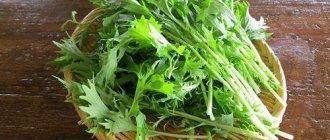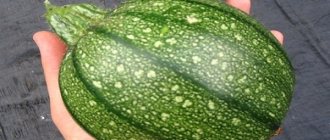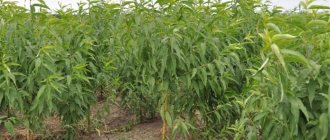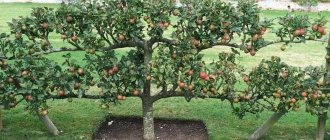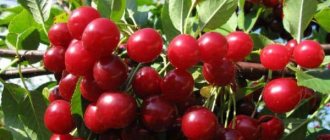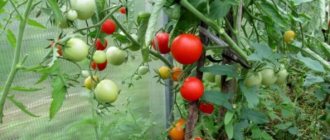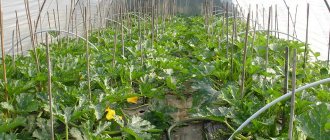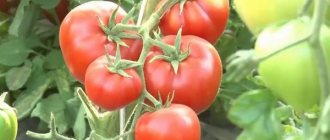The Aport apple tree is rightfully considered one of the oldest varieties in the world, which probably began its pedigree in Ukraine, and then spread to European countries, the USA and Canada.
Gradually, based on the original variety, varieties were developed that were adapted to local conditions.
This is how Aport Dubrovsky, Pushkinsky, Kubansky, Bely and a number of others appeared. But the first place among them is occupied by Almaty Aport, which has become widespread in Kazakhstan.
Description of the apple tree
Aport is a late-ripening variety that produces its first harvest 4 to 5 years after planting. The trees grow of medium height, with a powerful and spreading crown.
The leaves grow at the ends of the branches, are dark green in color, and slightly bent.
During flowering, the apple tree is covered with white flowers . Apples are distinguished by their large size and juicy sweet and sour taste.
Suitable for fresh consumption, for making preserves, jams, dried fruits, and wine.
Commercial and consumer qualities of fruits
The apples are large, have a truncated conical or wide conical shape, with not very pronounced ribbing. Their average weight is 250-270 g, but often it can reach 500-600 g, and in Almaty - even 900 g. The fruits are covered with fragrant, shiny, slightly oily, medium-thin skin with noticeable subcutaneous points. The main color is light yellow or greenish-yellow, with a dark red streaked blush covering more than half of the surface of the fruit.
The intensity and brightness of the blush depend on the weather and climatic conditions of the growing region
The fine-grained, aromatic, crumbly, medium-density, greenish-white pulp contains a large amount of vitamins and microelements. The average tasting score is 4.7 points (out of 5), the memorable feature is a pleasant wine aftertaste. In the middle zone, due to lack of heat, the taste properties of apples are not fully revealed.
Studies conducted in Crimea showed the presence in the biochemical composition of:
| Nutrients and beneficial substances | Quantity per 100 g of product |
| Vitamin C (ascorbic acid) | 10-12 mg |
| Sahara | 10.4-14.0 g |
| Acids | 0.6-0.8 g |
| P-active substances | 85-120 mg |
| Solids | 11-16.55 g |
Fruit ripening occurs in the second half of September - October, the consumer period begins in November. Apples tolerate transportation well; when stored in the refrigerator or cellar, they remain fresh and tasty until February (maximum six months).
When dried, the pulp almost does not darken, so apples are often used for preparing dried fruits.
In addition to fresh consumption, the fruits are excellent for making preserves, fresh juices, juices, compotes, jellies, marmalades, candied fruits and wine.
History of selection
The first mention of the Aport variety dates back to 1175. One of the monastic chronicles indicates that the variety was brought to the Kingdom of Poland from the Ottoman Empire. In addition, it is documented that in the 12th century this variety grew on the territory of Ukraine. Therefore, it is likely that this variety originally had Ukrainian roots.
In Russia, the variety was first described in 1779 by breeder Bolotov . From the beginning of the 19th century, Aport began to actively spread in Europe - Germany (where it received the name “Russian Emperor Alexander”), Belgium, France, and England. The variety was then introduced to the USA and Canada.
The original variety was used for breeding in new regions - grafted onto local varieties or wild apples, as a result new varieties of the variety appeared. Among them are Almaty, Kuban, Bely and others.
Description and distinctive features
The trees and fruits of "Aporta" differ significantly from other popular varieties, and therefore their description is very interesting.
The trees, as a rule, are vigorous, have a spreading, flat-rounded, non-thickened crown and a small number of skeletal shoots with a small number of lentils, colored brown. The trunk diameter varies from 8 to 10 m.
The peel covering the apple has a medium thick, dense structure with a slight oily and glossy sheen.
There is also a pronounced waxy coating and numerous large subcutaneous dots that are pale green or white in color. The fruit pulp is white, fine-grained in structure, with a delicate greenish tint and a sour-sweet, spicy and crumbly taste.
Peculiarities
A distinctive feature of this variety is the size of the fruits, whose average weight is 300 g , but there are often cases when the tree produces a harvest of half a kilogram apples. This is a high-yielding variety suitable for growing in climate zones with moderate winters.
The variety is not resistant to such common diseases as scab and moniliosis. Therefore, for successful growth it is necessary to carry out preventive measures against diseases and pests. The fruits tolerate transportation well and are stored for quite a long time if storage conditions are met.
Aport is a winter apple variety, just like Antonovka.
Tree height
Aport is a medium-sized variety, as it grows up to 5-6 m in height.
Crown width
The crown grows powerful, branched , and reaches 10-12 m in width.
Productivity
Aport has fairly high yields - a mature tree at the peak of fruiting produces about 150 kg.
Tasting assessment
The taste of the fruits of the Aport variety is sweet and sour, with a wine aftertaste . Tasting score 4.6-5.0 points.
Frost resistance
Aport does not tolerate frost very well, so it is recommended for cultivation in regions with moderate winter temperatures.
However, it should be noted that in the process of spreading the variety, varieties were developed .
These varieties of apple trees were better adapted to the conditions of frosty winters.
Self-fertility
This variety can be grown without pollinators, but this will result in reduced yield. Therefore, if possible, it is better to plant a suitable pollinator nearby.
Timing of flowering and harvesting of apples
This variety blooms in June with delicate white flowers. Aport is a late variety - harvesting begins in late September or early October.
Pollination
The following varieties of apple trees are best suited as pollinators: Shield, Pamyat Esaul, Prikubanskoye.
Dimensions
The fruits grow very large, weighing 270 - 300 g, although fruits weighing up to 600 g are not uncommon. The shape of the fruit is round, slightly flattened . The skin is medium thick, slightly oily, red-green in color with yellow spots. The pulp is white, medium density, crumbly.
Beginning of fruiting
Aport is distinguished by a fairly rapid onset of fruiting - most often the first harvest appears 4-5 years after planting the seedling. However, the variety bears fruit periodically - once every two years.
We also recommend that you read materials about other interesting varieties - Berkutovskoe, Grushovka, Konfetnoe, etc.
Description of the cultivar Aport Alexander
Alexander is the most common clone of the crop, having only minor differences in the color of the peel and pulp from the true Aport. Let's look at the characteristics of the Alexander clone.
Tree
The cultivar forms trees from medium growth vigor. The height of the tree exceeds 5 meters. The culture is characterized by a powerful crown of medium density, formed on developed skeletal branches. Its diameter reaches 10 m, its shape is oblate-oval. Fruiting of mixed type fruits are formed on ringlets and fruit twigs. Emerald foliage has average parameters.
Fruit
Aport apples are easy to recognize by their appearance. The varietal qualities are highly valued by experts and amateurs. At numerous exhibitions, Alexander is always among the first, for which the people called the apples souvenirs. Let's take a closer look at the characteristics of the fruit:
- The size of apples is described by pomologists as large and very large. On average, apples weigh from 220 to 280 g, but specimens weighing half a kilo are not at all uncommon.
- The shape of the fruit is oblate-conical; some fruits exhibit slight ribbing.
- The peel is yellow or yellowish-green, half covered with a rich dark red tan, in the form of streaks.
- The thickness of the skin is average, but very dense. The oily, slightly rough cover is protected by a layer of waxy coating and has a glossy appearance.
- The skin is dotted with a large number of pronounced subcutaneous freckles of white or greenish color.
- In terms of taste, it is unlikely that at least one hybrid can compare with Alexander and his relatives. The taste characteristics are rated by experts as the highest.
- When cut, crumbly, fine-grained white pulp with a soft greenish tint is visible. The flesh is medium in firmness, the texture is tender, and the taste is wine-sweet with moderate aroma and plenty of juice.
- Fruits of universal use, suitable for fresh consumption and processing. Juices, sweets, wines, and jams are made from apples. Dried fruits are of high quality, since the pulp does not change color after drying.
- Apples are removed from the tree by the end of September; within a month they acquire the qualities inherent to the variety. The keeping quality is excellent - the fruits do not lose their appearance and taste for up to six months.
- Thanks to the dense elastic peel, the fruit can be transported over long distances.
Advantages and disadvantages
The foremother endowed her descendants not only with obvious advantages, they also have disadvantages:
- Late entry into fruiting season. The apple tree will bear its first fruits only after 6-8 years;
- The crop bears fruit irregularly. Alexander has a cyclical fruiting pattern; a full harvest is harvested once every two years;
- The degree of frost resistance is assessed as borderline. The variety winters well and tolerates the weather conditions of the Black Earth Region, but in central Russia it is at risk of freezing without shelter for the winter;
- Weak immunity. The apple tree is at risk of moniliosis and scab.
Because of these characteristics, the cultivar is used less and less for industrial cultivation.
But reviews from amateur gardeners about the variety are positive, because in small areas it is easier to pay attention to each tree, carry out treatment in a timely manner, preventing disease
The positive side of culture outshines all the shortcomings:
- high yield - up to 150 kg of fruit from each adult specimen;
- high commercial and consumer qualities;
- attractive appearance, unique taste, large fruit size;
- long period of consumption, excellent keeping quality, transportability of fruits;
- Versatility of crop use;
- trees bear fruit for up to forty years.
The description of the variety states that when growing, it is necessary to follow the fertilizer application schedule. Excess nitrogen reduces yields and frequency of fruiting.
Growing region
Due to its weak frost resistance, Aport is best suited for cultivation in southern regions with warm climates.
Even in the middle zone, Aport may not survive the winter - there are many cases where trees could not withstand frost and died.
It can be grown in the middle zone, but with some risk. Sometimes grafting Aporta onto more frost-resistant varieties helps.
Expert opinion
Klimkina Elena Vladislavovna
Florist, businessman. Organized her business on a country plot of land
For the Urals and Siberia, the stylized form of Aport is used - the crown of the tree is formed in such a way that the main branches are covered with snow in winter. Thanks to this, the branches are protected from the effects of low temperatures.
Formation occurs as follows:
- When planting, the seedling is placed at an angle of 45°.
- Then, when the tree has taken root, the central branch is removed, and the skeletal branches are attached to the soil with special hooks.
Advantages and disadvantages
The high yield and size of apples is a very attractive quality for all gardeners. Everyone wants to try to grow a half-kilogram apple in their garden, and this is quite possible.
Aport is a very productive variety that can produce 150 kg of apples from one tree
The taste qualities of apples and their appearance have more than once earned the highest tasting ratings at various exhibitions and forums. For this combination, Aport apples are called souvenir apples.
And even though in industrial farms this variety has almost been replaced by other more modern ones, on private farms it is still one of the most desirable guests precisely because of its taste and appearance. And in Kazakhstan it is almost recognized as a national treasure. In 2009, a commemorative coin was even issued with the image of Almaty Aport.
Apples are well preserved at home, especially on the balcony or in the refrigerator. They are easy to transport.
But every medal has its other side. If in the conditions of the southern regions of Russia Aport survives the winter well, then in the middle zone in the temperate climate zone some problems are already arising . There are cases when, after harsh winters, trees froze completely. Nevertheless, some gardeners who grafted Aport onto more frost-resistant varieties avoided problems with wintering.
Relative resistance to scab is not Aport’s strong point, so you’ll have to keep an eye on it carefully. There is also a possibility of it being affected by fruit rot.
Irregular fruiting is also unlikely to please gardeners. However, the size of the fruits and their volume are worth allowing the apple tree to rest peacefully for one year.
Reviews
- Natalya, teacher : “I’ve known this variety for a long time. When the harvest is large, we manage to make jam and compotes, and we also make juice. And my relatives also make quite tasty wine from it.”
- Mikhail, engineer : “Aport has a rich aroma and excellent taste. The only thing is that it takes up a lot of space, since the crown is very spreading. We had to replant neighboring trees due to lack of space.”
- Inga, musician : “We inherited two trees from our grandmother, so they are already more than 20 years old. They don't bear fruit every year, but the harvests are still quite plentiful. Don’t forget about fertilizing and prevention against scab, otherwise they will get sick and have poor fruit production.”
- Olga, doctor : “We were lucky to get a seedling of the Almaty Aport - we grafted it onto the wild game, since we were not sure that the tree would take root in our Moscow region. A few years later, the apple tree pleased us with its first harvest - the apples were very juicy and aromatic, and lasted quite a long time.”
- Nikolay, pensioner : “The first Aport seedling did not survive the winter, so we were more careful with the second one - we carefully covered it for the winter, and applied fertilizer in spring and autumn. As a result, the tree began to bear fruit in the 7th year, and the harvest pleased me with both size and taste. I know that the variety is quite capricious, so I have to work hard with it.”
Nuances of fruiting
On average, after planting, Aport begins to bear fruit at least 5-7 years after planting. However, if you compare this period with the ripening period of other varieties of apple trees, this will happen quite quickly. Its flowering looks unusually beautiful. It begins in June, and the entire tree is literally covered with small white flowers that have a pleasant aroma.
This variety is usually classified as late-ripening. The fruits appear only towards the end of September. After picking, the fruits easily tolerate long-term storage and transportation. But, despite the fact that Aport apples can be stored for quite a long time, their taste deteriorates over time. They become loose, soft, and lose their original aroma.
Aport apples, which originate from the city of Almaty, are a unique variety. It has an unsurpassed combination of taste and size. Due to its high yield, it literally became a legend. If you approach planting and caring for such an apple tree properly, you can really get a rich, “thoroughbred” harvest.
Varieties and their photos
Due to its fairly wide distribution in different regions, several varieties were bred based on Aport, which have some differences .
Alexander
In fact, this is the ancestor of the Aport variety, which got its name after appearing in Germany and then in England.
Blood red
The fruits are blood-red in color, the pulp is medium-grained, with a slightly spicy taste. The apple tree bears fruit once every four years , since after a year with a large harvest, it is necessary to cut out all the fruit buds on the apple tree.
Thanks to this, in the first year the apple tree rests, in the second year it produces several dozen apples, in the third year the harvest reaches 60 kg, and in the fourth year it brings the richest harvest. Then the cycle repeats again.
We invite you to watch a video about the Blood Red Aport apple tree:
Almaty
It was bred in Kazakhstan, where it quickly became a kind of pride of the country. The fruits of this variety are striking in their size, as they reach a weight of 900 g. Moreover, the best harvest is produced by trees growing in the mountains, at an altitude of 900 to 1200 m above sea level. Almaty Aport is stored for a long time - it can last until May .
Dubrovsky
This is a semi-dwarf rootstock (up to 2.5 m high), characterized by high winter hardiness and good adaptive qualities.
Pushkinsky
The variety is zoned for cultivation in the Moscow region, as it tolerates frost well. The tree begins to bear fruit at 5–6 years. The apples grow large, weighing up to 250 g, with a spicy taste and strong aroma.
Kubansky
It is best suited for growing on low-growing rootstocks, has good immunity against most diseases, and is frost-resistant. Apples ripen in mid-September , but are not stored for long - no more than 2 months.
White
Based on the name, the fruits of this variety differ in color from the original variety. In other respects, the variety is similar to Aport Dubrovsky.
Slate form
Suitable for growing in areas with harsh winters, such as the Urals or Siberia.
Harvest and storage
Apples are harvested from trees in October. Fruits picked from apple trees are stored in cellars for up to 3 months. Sometimes longer periods are possible, but in this case, fruits can quickly begin to deteriorate during long-term storage: their taste deteriorates, and the consistency of the inside becomes loose and loses its aroma.
Find out how long to keep apples fresh for the winter at home.
By growing an apple tree of the Aport variety and following the correct agricultural technology algorithm, you can achieve long-term fruiting. Although this varietal variety is not distinguished by stable yields and winter hardiness, its large, beautiful and tasty fruits will be a worthy compensation for the efforts made.
Growing rules
A young tree of the Aport variety is watered 1 or 2 times a week . It is especially important to monitor the condition of the soil during hot weather. More frequent watering may be required. The entire perimeter of the tree trunk circle should be watered, and not just the area near the trunk. After watering, be sure to loosen so that oxygen can flow well to the roots.
To additionally preserve moisture in the ground, it is recommended to mulch the apple tree with sawdust, humus or rotted manure at least 5 cm thick. Trimming is also important for this variety, as it serves several purposes - sanitary, rejuvenating and shaping.
The first pruning is done in the 2nd or 3rd year after planting in the spring, before the appearance of buds and sap flow. Branches growing inside the crown, as well as old and diseased branches, are cut out.
If a tree becomes sick in the middle of the season, sanitary treatment is carried out as soon as possible, without waiting for spring. During formative pruning, branches that intersect or rub against each other are removed.
In general, Aport’s crown is not very dense, so it does not require heavy pruning .
When to plant and how to choose?
Since Aport does not tolerate frost well, it is best to plant a young tree in the spring, starting in mid-April. This way, over the summer, the seedling will have time to take root, grow stronger and gain strength for a successful winter.
The seedling should be chosen no older than 2 years - it should have 2 - 3 additional branches growing at an angle of 50 - 90°, with well-developed roots.
1 - 2 days before planting, it is worth placing the seedling in water , and immediately before planting for 1 - 2 hours you can put the seedling in a solution with a diluted growth stimulant (for example, “Kornevin” or “Heteroauxin” are suitable). This will increase the survival rate of the young tree.
Selection and preparation of a site, distance to other trees
The best soil is well-drained loam. However, cultivation on other types of soil is allowed, subject to preliminary preparation of the site - first, dig a hole of a meter in diameter and pour a mixture of sand, compost and peat chips into it. Since the apple tree does not like excessively moist soil, the planting site is chosen on a hill.
- If the area is flat, you can create an artificial hill around which drainage grooves can be dug to remove excess moisture. Aport, like other apple trees, loves a well-lit place protected from the wind. You need to prepare the hole at least a week before planting, but better in the fall. The hole should be 1 m deep and wide.
- The excavated soil is mixed with a bucket of sand, a bucket of peat, and 800 g of wood ash. It is also worth adding mineral fertilizers - superphosphate, potassium sulfate, potassium salt are suitable.
- Next, the seedling is placed in a hole, the roots are carefully distributed and gradually covered with soil, shaking periodically so that there are no voids around the roots. The root collar should remain 8–10 cm above the ground.
- Finally, the seedling should be watered generously with water (about two buckets) and mulched with a mixture of humus and peat.
Since the crown of Aport grows very wide and spreading, it is better to leave the distance to other trees, fences or outbuildings at least 5 meters.
Need for transplant
Aport does not require replanting, but if there is a need for one, it should be done in early spring before the leaves appear. The tree is dug up with a large lump of earth (the diameter of the lump should be approximately equal to the diameter of the crown) and carefully dragged on a piece of cloth to a new location.
The hole should be prepared in advance according to the same principle as during the initial planting of a seedling - that is, add fertile layer and fertilizer.
Feeding
The first feeding of Aport should be done in the 3rd year after planting:
- First, in the fall, organic fertilizers are applied (compost, rotted manure), which are distributed around the tree and slightly buried during loosening.
- Then in early spring you can add urea - if the soil is moist enough, you can use dry urea (500 - 600 g).
- If the weather is dry, you can prepare a urea solution at the rate of 30 - 50 g of fertilizer per 10 liters of water.
Before flowering and during fruit set, phosphorus-potassium fertilizers are applied. For these purposes, slurry (0.5 buckets), 1.5 - 2 liters of liquid chicken manure or 100 g of superphosphate along with 60 - 70 g of potassium are suitable. Each of these fertilizers is dissolved in 10 liters of water.
Expert opinion
Klimkina Elena Vladislavovna
Florist, businessman. Organized her business on a country plot of land
In the fall, fertilizing is also carried out using a mixture of potassium (1 tbsp), double superphosphate (2 tbsp) and calcium (1 tbsp). This mixture is diluted in 10 liters of water and root feeding is performed. Feeding will allow the tree to get stronger and gain strength for the winter .
Landing
Since Aport is a winter variety, it is preferable to plant it in the fall for better survival. For planting, seedlings with a well-developed root system are selected. Trees with a closed root system take root best. The most suitable soil for growing will be well-drained loam - it is on it that the apple tree will show all its best qualities.
If your site has a different type of soil, then you can dig a hole a meter in diameter and pour a mixture of sand, compost and peat chips into it - this will significantly improve the conditions for the seedling to take root.
The place for the apple tree is chosen to be open, sunny, with groundwater deeper than one meter. If the water horizon is located closer to the surface, it is recommended to artificially create a small hill from the fertile layer and thereby increase the space for roots. In this case, it is important to build grooves through which excess moisture will be drained.
The root collar of the apple tree should be above ground level
The hole is dug based on the size of the root system of the seedling, but if the soil is poor in nutrients, you can dig a hole one meter wide and deep, placing on the bottom a nutrient mixture of peat (22–25 kg), compost or humus (15–18 kg) and fertile soil layer . This mixture forms a mound on which the seedling will be placed. If its root system is open, the roots spread down towards the slopes of the hill. Then the hole is filled with earth, holding the tree by the trunk and shaking it periodically so that no voids form between the roots.
The root collar should be several centimeters above ground level; do not bury it under any circumstances, otherwise it will have a detrimental effect on the growth and development of the apple tree or even lead to its death.
It is best to prepare a hole with a nutrient mixture a week before planting, so that the filler has time to compact and after planting the subsiding soil does not carry the seedling along with it. It is also not recommended to compact the vertical walls of the hole with a shovel, so as not to prevent the roots of the seedling from spreading in all directions.
When planting, the apple tree is watered abundantly until water begins to linger on the surface.
After planting, create an earthen roller around the trunk of the apple tree along the periphery of the trunk circle and water it abundantly until the water stops being absorbed. The tree trunk circle is mulched with peat or humus.
Diseases and pests
Aport, unfortunately, is not highly resistant to diseases:
- In particular may be affected by scab. To prevent it, wood is treated with a solution of urea (700 g per 10 l of water) and copper sulfate (50 g per 10 l of water).
You can also use a solution based on wood ash - 1 cup of ash is poured with boiling water and then dissolved in 10 liters of water.If the tree still gets scab, you can use urea and copper sulfate in higher concentrations. Also, for spraying before flowering, a solution of the drug “Hom” (40 g per 10 liters of water) is suitable - you will need from 2 to 5 liters per tree.
- Another danger to Aport is the tinder fungus , which likes to settle on trees of this variety.
The mushroom takes nutrients from the apple tree, so while it is soft, it should be cut off as soon as possible with a regular garden knife. If the mushroom has already hardened, it can only be removed with an ax. This should be done carefully, trying not to damage the wood. The damaged area is treated with a solution of copper sulfate (100 g per 10 liters of water) and oil paint is applied. - often affected by a disease called moniliosis, or fruit rot . Treatment with colloidal sulfur (100 g per 10 l of water) or a suspension of karbofos (50 or 100 g per 10 l of water) can successfully combat this disease.
- Green aphids and codling moths also love Aport . A 0.3% solution of entobacterin will help in the fight against green aphids. For codling moths, karbofos and chlorophos are used. To control pests, one treatment is not enough - it is necessary to carry out 5 - 7 sprayings per season with a frequency of once every two weeks. The last treatment is done 20 days before harvesting.
Aport, thanks to its long history, is known in many parts of the world. Large fruits with rich aroma and taste attract many apple lovers. A tall, spreading tree can produce crops for up to 40 years, the quality of which, subject to proper care, will be quite stable. However, the characteristics of the variety make it attractive for cultivation only in warm climatic zones, where there is no threat of severe frosts.
Disease resistance, winter hardiness
The main problem with Aport is that it is not winter hardy. If you live in the north, then in winter the tree will simply die. That is why this type of apple is not grown in Siberia, as well as in the northern regions of our country. An alternative solution to this problem would be to grow its clones; they have high winter hardiness. Aport is also unstable to various diseases, including scab.
If you still decide to grow the original Aport variety in your garden, then you need to be patient. It is important to regularly feed the tree and monitor its condition,
How did it arise?
The Aport apple tree variety was brought to the city of Almaty (formerly the district city of Verny) in the 80s of the 19th century by E.V.
Redko and hereditary breeder N.T. Moiseev. Several apple tree seedlings were planted in the garden of the foothill zone, which acclimatized well and pleased with an excellent harvest.
In their historical homeland, the fruits of this variety were not characterized by anything remarkable, but in the favorable conditions of Alma-Ata they acquired a unique taste , magnificent color and an unprecedented size of fruit - up to 1 kilogram.
After some time N.T. Moiseev created an industrial nursery where Aport Alma-Ata was cultivated. At the end of the 19th century, the variety spread widely in the Trans-Ili Apatau, and then it became known throughout the world and more than once received awards in the form of gold medals at world exhibitions.
Thanks to excellent transportability, large fruits and their excellent taste, apples from Almaty Aport were exported far to Siberia.
At the beginning of the 20th century, fruits from Vernensky district became popular in the central regions of Russia . At the end of the 70s of the last century, Aport Almaty (or Vernensky) became a symbol of the city of Almaty.
How to grow Aport depending on your region
Moscow region
In the Moscow region, simply plant the Pushkin subspecies, which is adapted specifically for your region. There are no difficulties in care: the same loosening of the soil, watering and timely fertilizing. There is no need for shelter for the winter.
Siberia and the Urals
It will be more difficult here, but everything is possible: purchase seedlings on winter-hardy rootstocks and grow them in stale form, so that the fruiting branches end up in the snow in winter and do not freeze. Then the harvests will really please.
Ukraine
Two subspecies of the Aport apple tree are successfully grown in Ukraine: blood-red Aport and Dubrovsky Aport. The rules of agricultural technology are described in the article above.
Altai
The most successful were seedlings on dwarf and semi-dwarf rootstocks, which have good winter hardiness and adaptive properties. the rules of care are the same: timely feeding, proper pruning, regular watering during fruiting.
Gardeners happily still grow this ancient variety, making efforts to adapt the apple tree to the climate conditions of their region. It is a pity that because of this, pure Aport Aleksandrovsky was lost, but at the same time the variety covered almost all regions of Russia. We hope that the work of the breeders will be crowned with success and one day gardeners will be able to purchase seedlings of the classic Aport. In the meantime, you can enjoy growing zoned subspecies of the Aport variety.
Zoning
This variety performed best in Kazakhstan, where it has long been considered a national treasure. A commemorative silver coin was even issued in his honor in 2009. In Russia, the recommended growing region is the North Caucasus.
In industrial horticulture, with the development of fruit crop breeding, this variety is gradually giving way to more modern varieties that have improved frost resistance and disease immunity. However, thanks to its excellent appearance and excellent taste, Aport continues to remain one of the favorite varieties in private gardening.
Description of apple trees Aport
The first mention of the Aport apple tree variety dates back to the beginning of the 12th century. After 2 centuries, trees with juicy fruits were brought from the Balkan Peninsula to neighboring Wallachia (the south of modern Romania) and Ukraine. From there the apple tree came to Russia and was named in honor of the Russian Emperor Alexander I by Aport Alexander.
Apples of the Aport Alexandra variety are easily recognized by their characteristic striped color and yellow flesh.
Origin of the variety
In Kazakhstan, Aport began to be bred thanks to the tradesman Yegor Redko, who in 1865 moved from the Voronezh province to the city of Verny (present-day Almaty) and brought with him apple tree seedlings. Gardener N.T. began improving the variety. Moiseev, who crossed Aport with the local wild Sievers apple tree. Thanks to successful selection, suitable weather conditions and soil, an improved variety of the variety appeared, which has survived to this day.
At the World Exhibition, which took place in 1900 in Paris, the fruits of the apple tree bred by Moiseev received a favorable assessment from experts and were included in the top ten popular varieties. In Kazakhstan, Aport's image is depicted on postage stamps and commemorative silver coins.
Large apples are harvested in early September, and they can be stored without loss of taste and appearance for 4 months
Main characteristics
Botanical description of the variety:
- vigorous tree, reaching up to 6 m in height;
- the crown is spreading and round, with a diameter of up to 12 m;
- shoots are elongated and strong, of medium thickness, brown;
- leaves are round, dark green in color, with slightly pubescent edges;
- the fruits are large, flattened-conical, with a dense and rough skin of a yellow-green color with an extensive red blush and a waxy coating;
- the taste of aromatic apples is sour-sweet. The pulp is juicy and tender, crumbly, greenish-yellow in color;
- the average weight of the fetus reaches 195 g;
- the harvest is harvested in September;
- The Aport apple tree is characterized by increased productivity: one tree produces on average up to 150 kg of fruit.
Aport fruits are used to make jam, marmalade, apple juice and wine with a pleasant aroma, as well as dried fruits.
Advantages and disadvantages
This variety of apple tree is a late-ripening variety, so the fruits retain their original taste and appearance for a long period. A special feature of Aport is the exceptional size of the fruits of the first harvest, the weight of which reaches 800 g. In subsequent years, the size of the apples becomes smaller and does not exceed 300 g.
After planting Aport, the apple tree bears fruit for almost 40 years, annually delighting with a fragrant and impressive harvest
The advantages of the variety include:
- excellent taste;
- large fruits;
- self-pollinating, so pollinating apple trees are not grown nearby;
- long fruiting period, which reaches up to 40 years;
- good transportability.
- cyclical fruiting. In the first year, the apple tree produces a record harvest, which reaches 180 kg; in the second year, the number of ripened fruits decreases to 40 kg. A year later, the yield increases to 60 kg, and in the next September a bountiful harvest is harvested again;
- average frost resistance. The apple tree cannot withstand cold winters with air temperatures below -25 o C;
- susceptibility to scab, cancer.

